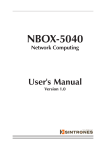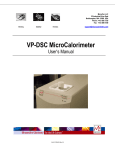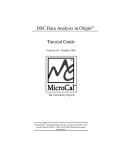Download Installation Bulletin: EDS3090 Series
Transcript
EDS3090 Series Installation Bulletin / Reference Guide This document is intended as a reference guide for installing and using a BENDER EDS3090 series ground fault location system for ungrounded systems. This document includes installation, setup, and usage instructions. For complete details, including installation, setup, settings, and troubleshooting, refer to the EDS3090 user manual, document number TGH1454en. This document is intended as a supplement and not a replacement to the complete user manual. Only qualified maintenance personnel shall operate or service this equipment. These instructions should not be viewed as sufficient for those who are not otherwise qualified to operate or service this equipment. This document is intended to provide accurate information only. No responsibility is assumed by BENDER for any consequences arising from use of this document. General Information General Procedure For Use (Cont’d) Application This documentation applies to the following versions of the EDS3090 series and their contents: Step 1B - Correct Settings on IRDH575 (kits not ending in “PG” only) Systems that do not end in “PG” (Including part numbers EDS3090 and EDS3091) require an IRDH575 ground detector be installed in the system. The IRDH575 includes the pulse generator function normally included with PGH183/PGH185 devices. Under menu option “EDS SETUP,” ensure the following settings are correct: • • • EDS3090 and EDS3091 (requires IRDH575/LIM2010 detector already installed in system) EDS3090PG and EDS3090PG-13 (standalone) EDS3091PG and EDS3091PG-13 (standalone) Refer to the complete user manual for information on other models and variants. Ensure all components of the kit are correct. Refer to table on reverse side for list of components for each kit. • Menu option “EDS”: Set to auto. • System: Set this to the correct type of system the device is on. For instance, for Threephase AC systems, select “3AC.” For DC systems, select “DC.” • MaxPuls: This setting must correspond to the type of kit being used. For EDS3090 systems, this must be set to 10 or 25 mA. For EDS3091 kits, this must be set to 1 or 2.5 mA. Important System Requirements Refer to the complete user manual for technical information regarding requirements for proper ground fault location, response characteristics, and other general use information not mentioned in this document. Refer to IRDH575 user manual for more information. Two different types of portable ground fault location systems exist. The EDS3090 kit is designed to be used with a BENDER IRDH575 ground detector that is already installed in the system. The EDS3091kit is designed to be used with a BENDER IRDH575 or LIM2010 already installed in the system. All EDS3090 kits ending in “PG” are designed to be standalone and do not require any other devices installed in the system. EDS3091PG models are designed for locating ground faults in small, low-voltage systems, such as control networks and healthcare facilities. EDS3090PG models are designed for medium to large scale distribution networks. • Set operation mode to I∆s. • Select the correct clamp. For the PSA3020 or PSA3320, select “P20.” For the PSA3052 or PSA3352, select “P52.” For the PSA3165, select “P165.” • Connect the appropriate clamp. How It Works A measuring signal is generated and superimposed on the system. When using the EDS3090, this signal is generated by the IRDH575 automatically after a ground fault is detected. When using a model ending in “PG,” the signal is generated manually by the PGH series pulse generator installed in the system. The measuring signal naturally travels through the ground fault, back to the source of the pulse generation. Using the EDS195P hand-held meter and appropriate clamp, the signal is traced down to the source of the ground fault. Step 2 - Set up EDS195P hand-held meter Below are the basic settings required for operation: Refer to the reverse side of this document for more information on using the EDS195P. Step 3 - Begin ground fault location Figure 2 below is a typical ground fault location schematic. Follow the general procedures below. NOTE: The steps below are for general applications, and some systems may require different procedures. Consult the manufacturer for more information. General Procedure For Use Step 1A - Install the pulse generator (kits ending in “PG” only) Only follow this step if using a kit ending in “PG” and an IRDH575 is NOT already installed in the system. Otherwise, go to step 1B. Kits ending in “PG” come with a PGH series pulse genera- HAZARD OF ELECTRIC SHOCK, tor kit. This kit must be installed in the circuit as far up- EXPLOSION, OR ARC FLASH stream as possible, in order to ensure all branches are included in the fault location. When using the PGH185, • Disconnect all power before servicing. voltages higher than 575 VAC or 504 VDC require an ad- • Observe all local, state, and national ditional AGE185 voltage coupler. codes, standards, and regulations. Connect the PGH series pulse generator as follows. Use the supplied cables and connectors for connections. ! DANGER • EDS195P ISOSCAN® PGH18x RF GND Figure 2 - Ground fault location on an ungrounded three-phase AC system Connect system connections: • Single-phase AC: Connect L1 and L2 to the system phases. • Three-phase AC: Connect L1, L2, and L3 to the three phases of the system. • DC: Connect L1 to system positive, L2 to system negative. • Connect ground connection to the system’s equipment ground. • Connect US to control power (90...132 VAC for “-13” models, 230 VAC for others) 1 6 2 Begin the pulse generation. Systems with IRDH575 devices should begin this automatically. Systems with PGH series pulse generators require pressing the power switch to the ON position. 2. Clamp around the ground wire connected to the IRDH575 / PGH series module. If a ground fault is present in the system, a visual and audible alarm should be present, reading the full magnitude of the tracer signal. 3. Begin at the appropriate branching point, such as a motor control center or loadcenter. The starting point must use cabling that is small enough to have all branch conductors passing through the clamp. 1. ON/OFF switch 2. Pulse magnitude switch (10/25 mA for PGH185, 1/2.5 mA for PGH183) 4. Go to branch 1. Clamp around all branch conductors. 5. Wait approximately 10 seconds. If no alarm activates, or no signal is detected, move to the second branch. Repeat for all branch circuits until an alarm is activated. 3. System connections 6. 4. Equipment ground connection If the alarm activates and the tracer signal is measured, follow the branch downstream to the load or next branch. If the circuit branches once again, repeat steps 3 through 6. 5. LED indicators: POWER on, positive cycle of signal, negative cycle of signal 6. Plug for supply voltage (90...132 VAC for “-13” models, 230 VAC for others) 5 4 1. 3 Figure 1 - PGH185 / PGH183 pulse generator Bender Inc. • USA: 800.356.4266 / 610.383.9200 / [email protected] • Canada: 800.243.2438 / 905.602.9990 / [email protected] • www.bender.org Document NAE1018031 • 08.2013 • © Bender Inc. • Page 1/1 • Side 1/2 EDS3090 Series Installation Bulletin / Reference Guide EDS195P Handheld Meter Menu Structure Flow Chart 1 2 EDS195P ISOSCAN ® 3 4 5 10 11 6 7 8 OK 12 The flow chart below shows the structure of the menu built into the EDS195P. The menu is used for making any necessary settings changes and viewing harmonics when in I∆n mode. Use the supplied gray boxes to take note of applied settings for future reference. 1. MicroUSB port for charging 2. Clamp connector 3. LCD display 4. Alarm LED 5. Operation mode pushbutton: Select I∆s for ground fault location mode. 6. Clamp selection pushbutton 7. INFO button: Displays system and device information 8. MENU / ENTER button: Opens the device’s main menu on the display / Confirms in main menu 1. EXIT 9. POWER button 2. Settings Menu or settings option Settings option essential for proper operation 10. HOLD / UP button: Freezes measured value / moves up in the device’s main menu 1. Exit 2. General 11. RESET / DOWN button: Resets held value / moves down in device’s main menu 12. Illumination button: Toggles backlight on display 3. IΔs 9 4. IΔn EDS195P: Display 5.System 1 12 11 2 3. Harmonics 1. Exit 2. Memory on off 3. Buzzer on off 4. AlarmLED on off 5. ItMax 5mA 50mA 1. Exit 2. Resp. 2...10 mA 200...1000 μA 3. System AC DC 4. Inverter yes no 1. Exit 2. Resp 10 mA ... 10 A 3. Freq 50Hz 60Hz Up to 2kHz 4. Harmonics on off 1. Exit 2. Language English French German 3. Clock 00:00 ... 23:00 1. Exit 2. H1 = X mA . . . 10 9 8 7 6 5 3 4 10. H9 = X mA 1. Progress bar, active during fault location 8. Lights when alarm status is latched (fault memory) 2. Indication of tracer signal: Positive peak, idle, negative peak 9. Indicates selected clamp / CT 3. System type (AC / DC) 4. Lights when hold activated (measured value is frozen) 11. Real-time measured value of ground fault current (usable in grounded systems - I∆n mode) 5. Battery life remaining 6. Lights when alarm LED output is active 7. Visible when audible alarm is activated in menu 4. Service 10. Indicates EDS system type (see below) 12. Magnitude of tracer signal, if measured (standard operating mode - I∆s mode) Scope of Delivery Using the EDS195P on Grounded Systems The EDS195P and clamps may additionally be used for ground fault current monitoring on grounded AC systems. To conduct measurements, the following steps are required: • Set operation mode to I∆s. • Select the correct clamp. For the PSA3020 or PSA3320, select “P20.” For the PSA3052 or PSA3352, select “P52.” For the PSA3165, select “P165.” • If desired, an alarm level may be set to activate the audible and visual alarms. This value may be set under the menu option SETTINGS > I∆n > RESP. If this value is not set, the currently read value will still display on the main screen of the EDS195P. • Connect the appropriate clamp. • Clamp around all branch conductors until a reading is displayed on the main screen. Use the table below to ensure all components of the kit are correct. Hand-held evaluator Current generator EDS195P EDS195P EDS195P EDS195P EDS195P EDS195P EDS195P EDS195P – PGH185 PGH185-13 PGH186 PGH186-13 – PGH183 PGH183-13 PGH supply voltage 20 mm clamp 52 mm clamp Type 230 V (50/60 Hz) 120 V (50/60 Hz) 230 V (50/60 Hz) 120 V (50/60 Hz) – 230 V (50/60 Hz) 120 V (50/60 Hz) PSA3020 PSA3020 PSA3020 PSA3020 PSA3020 PSA3320 PSA3320 PSA3320 PSA3052 PSA3052 PSA3052 PSA3052 PSA3052 PSA3352 PSA3352 PSA3352 EDS3090 EDS3090PG EDS3090PG-13 EDS3096PG EDS3096PG-13 EDS3091 EDS3091PG EDS3091PG-13 Technical Data Refer to EDS3090 series user manual (document TGH1420en) or EDS3090 series datasheet (document NAE1012031) for detailed technical information on EDS3090 systems and components. Bender Inc. • USA: 800.356.4266 / 610.383.9200 / [email protected] • Canada: 800.243.2438 / 905.602.9990 / [email protected] • www.bender.org Document NAE1018031 • 08.2013 • © Bender Inc. • Page 1/1 • Side 2/2





















